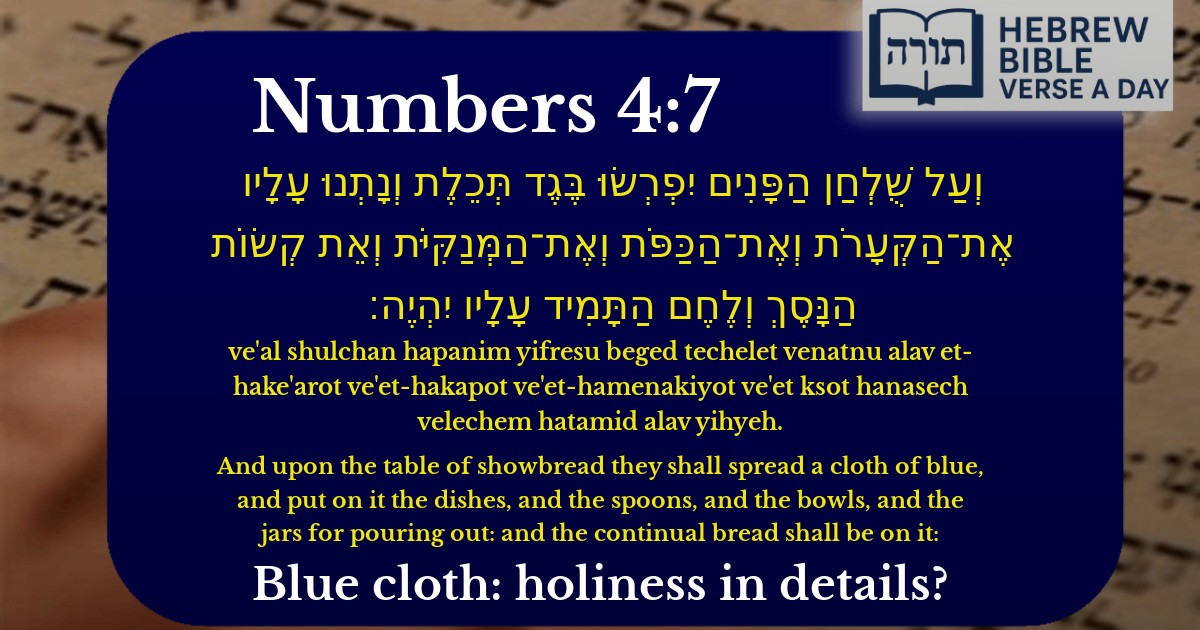Join Our Newsletter To Be Informed When New Videos Are Posted
Join the thousands of fellow Studends who rely on our videos to learn how to read the bible in Hebrew for free!
Hebrew Text
וְעַל שֻׁלְחַן הַפָּנִים יִפְרְשׂוּ בֶּגֶד תְּכֵלֶת וְנָתְנוּ עָלָיו אֶת־הַקְּעָרֹת וְאֶת־הַכַּפֹּת וְאֶת־הַמְּנַקִּיֹּת וְאֵת קְשׂוֹת הַנָּסֶךְ וְלֶחֶם הַתָּמִיד עָלָיו יִהְיֶה׃
English Translation
And upon the table of showbread they shall spread a cloth of blue, and put on it the dishes, and the spoons, and the bowls, and the jars for pouring out: and the continual bread shall be on it:
Transliteration
Ve'al shulchan hapanim yifresu beged techelet venatnu alav et-hake'arot ve'et-hakapot ve'et-hamenakiyot ve'et ksot hanasech velechem hatamid alav yihyeh.
Hebrew Leining Text
וְעַ֣ל ׀ שֻׁלְחַ֣ן הַפָּנִ֗ים יִפְרְשׂוּ֮ בֶּ֣גֶד תְּכֵ֒לֶת֒ וְנָתְנ֣וּ עָ֠לָ֠יו אֶת־הַקְּעָרֹ֤ת וְאֶת־הַכַּפֹּת֙ וְאֶת־הַמְּנַקִּיֹּ֔ת וְאֵ֖ת קְשׂ֣וֹת הַנָּ֑סֶךְ וְלֶ֥חֶם הַתָּמִ֖יד עָלָ֥יו יִהְיֶֽה׃
Parasha Commentary
📚 Talmud Citations
This verse is quoted in the Talmud.
📖 Menachot 96b
The verse is discussed in the context of the arrangement of the showbread table in the Temple, particularly regarding the covering of the table with a blue cloth and the placement of the vessels and bread.


Context of the Verse
This verse (Bamidbar 4:7) describes the procedure for covering and transporting the Shulchan (Table of Showbread) during the travels of the Israelites in the wilderness. The Shulchan was one of the sacred vessels in the Mishkan (Tabernacle), holding the Lechem HaPanim (Showbread), which was arranged weekly and symbolized Hashem's constant providence.
Cloth of Blue (בֶּגֶד תְּכֵלֶת)
Rashi explains that the blue cloth was the first covering placed directly on the Shulchan before the vessels were arranged on top. The color techeilet (blue) is significant—it resembles the sea, which resembles the sky, which resembles the Divine Throne (Chullin 89a). This symbolizes the heavenly source of sustenance, as the Shulchan represents material blessing.
The Vessels Placed on the Shulchan
The Lechem HaPanim (לֶחֶם הַתָּמִיד)
The verse emphasizes that the bread must remain on the Shulchan even during transport. The Ramban notes that this teaches the eternal presence of Hashem's blessing—even in transition, the symbol of sustenance remains. The Talmud (Menachot 99b) derives from this that the bread was never entirely removed; new loaves were placed before the old ones were taken, ensuring continuity.
Symbolism of the Shulchan
The Midrash (Bamidbar Rabbah 4:16) teaches that the Shulchan represents material prosperity granted by Hashem. The blue cloth and orderly arrangement of vessels signify that physical sustenance is elevated when used for holiness. The Sforno adds that the Shulchan’s prominence in the Mishkan teaches that economic success must be directed toward divine service.